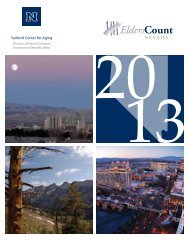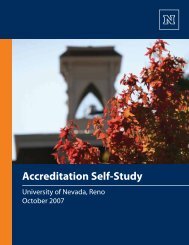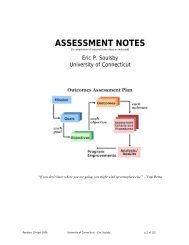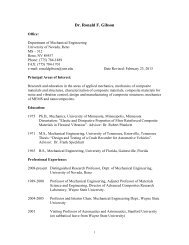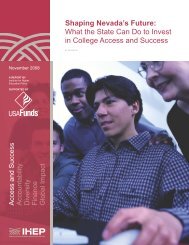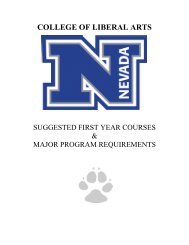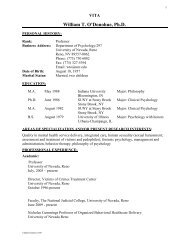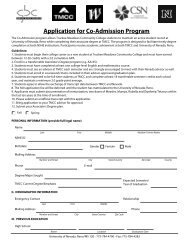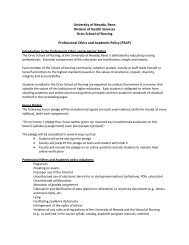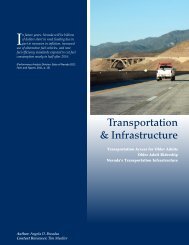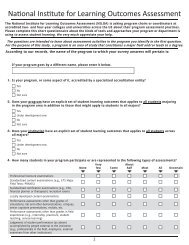Download full issue - University of Nevada, Reno
Download full issue - University of Nevada, Reno
Download full issue - University of Nevada, Reno
Create successful ePaper yourself
Turn your PDF publications into a flip-book with our unique Google optimized e-Paper software.
Sharing expertise with<br />
colleagues and consumers<br />
Wilson’s programs, classes and online<br />
courses have taught <strong>Nevada</strong>ns about a remarkably<br />
broad range <strong>of</strong> topics, from coronary heart<br />
disease to wellness to food safety. In many<br />
cases, her work has reached the people who<br />
need it the most, including seniors receiving<br />
commodity foods and low-income families.<br />
What’s more, Wilson has generously shared<br />
her expertise with nutrition experts around the<br />
country and within Cooperative Extension.<br />
Since Wilson took over in 2005 as the administrator<br />
<strong>of</strong> Cooperative Extension’s Supplemental<br />
Nutrition Assistance Program (SNAP) Education<br />
grant, formerly known as Food Stamp<br />
Nutrition Education, the number <strong>of</strong> federally<br />
funded extension programs has grown from<br />
six programs to 16, and the amount <strong>of</strong> grant<br />
funding has jumped from $427,742 to more<br />
than $1.22 million.<br />
As the state coordinator for the Expanded<br />
Food and Nutrition Education Program, she<br />
has taken a national leadership role, such as<br />
when she coordinated pilot research in five<br />
states to test a new evaluation strategy for<br />
the program. Her close examination <strong>of</strong> the<br />
geographic areas being served by the Expanded<br />
Food program led her to recommend hiring<br />
more Spanish-speaking and African-American<br />
parapr<strong>of</strong>essionals for the program.<br />
As a result, the Expanded Food program last<br />
year reached 1,051 participants in <strong>Nevada</strong> with<br />
incomes below the poverty line.<br />
Partnerships are central<br />
to her programs<br />
In addition to her leadership and skilled<br />
management, Wilson also enjoys collaborating<br />
with <strong>University</strong> experts from other disciplines.<br />
One example is her 20-year-old “Apple a<br />
Day” program, in which she has partnered<br />
with the School <strong>of</strong> Medicine to deliver free<br />
educational materials through physicians’<br />
<strong>of</strong>fices about proper nutrition. She also recently<br />
worked with extension exercise physiologist<br />
Anne Lindsay on a training program called<br />
“Eat Healthy Be Active”, an online chronic<br />
disease and injury risk-reduction program that<br />
emphasizes good nutrition and physical activity<br />
to improve employee health and decrease<br />
absenteeism and health care costs.<br />
One <strong>of</strong> her favorite programs, and one that<br />
surprised her with its popularity, is called “Eat<br />
Smart Live Strong,” where she teams up with<br />
extension horticulturist Angela O’Callaghan<br />
to teach seniors how to grow herbs indoors and<br />
then use those herbs to prepare tasty meals<br />
from the commodity foods—such as canned<br />
vegetables and fruits, canned meat and whole<br />
wheat pasta—the seniors receive.<br />
While doing research prior to developing the<br />
program with O’Callaghan, Wilson interviewed<br />
several seniors and determined that<br />
many were at risk <strong>of</strong> malnutrition. They didn’t<br />
understand how food expiration dates worked,<br />
and they were frequently tired <strong>of</strong> eating the<br />
same commodity foods over and over.<br />
Secret ingredients<br />
<strong>of</strong> success<br />
Wilson and O’Callaghan have conducted<br />
the class several times since launching the<br />
program, and they are enjoying great success.<br />
O’Callaghan shows seniors how easy it<br />
is to grow herbs and small vegetables in their<br />
homes, and Wilson demonstrates recipes using<br />
the herbs and the commodity foods. Usually<br />
there is a tasting, and one <strong>of</strong> the seniors’<br />
favorites is glazed carrots with mint grown on<br />
the windowsill.<br />
“Seniors love to come to this class,” Wilson<br />
says. “People generally aren’t that receptive to<br />
nutrition classes because no one wants to make<br />
the kind <strong>of</strong> changes I’m usually asking them to<br />
make.<br />
“But this class is different,” she adds. “After<br />
the first session (<strong>of</strong> a five-week program),<br />
they’re hooked.”<br />
Wilson’s analysis found that participants eat<br />
more fruits and vegetables after completing the<br />
program. She also found that the potential risk<br />
for malnutrition among people who have completed<br />
the program declines dramatically. But<br />
just as importantly, seniors come away from the<br />
class feeling that they have more control over<br />
their lives and are less helpless in dealing with<br />
problems, Wilson says.<br />
“I threw away a million bad habits,” says one<br />
participant after a class at the East Valley Family<br />
Resource Center in Las Vegas. “This is one<br />
<strong>of</strong> the best things we’ve ever done here.”<br />
Looking for new ways to<br />
reach more people<br />
Wilson says the need for getting good nutrition<br />
information to low-income families has<br />
never been more important. She says that more<br />
than 310,000 <strong>Nevada</strong>ns were receiving supplemental<br />
nutrion benefits in 2010—a 61 percent<br />
increase since 2009—and people are signing<br />
up for help at a rate <strong>of</strong> about 5,000 participants<br />
a month.<br />
These difficult economic times—exacerbated<br />
by increasing health care costs—have prompted<br />
her to find more efficient ways to reach more<br />
<strong>Nevada</strong>ns with vital information about their<br />
diets. That’s why she and Lindsay worked with<br />
Jill Wallace, a <strong>University</strong> instructional design<br />
expert, to develop the 12-week online education<br />
series for “Eat Smart Be Active,” which<br />
encourages worksite wellness by emphasizing<br />
nutrition and exercise.<br />
Meanwhile, her “Calcium, It’s Not Just Milk”<br />
program uses a “train the trainer model” in<br />
an effort to reach even more middle school<br />
students in low-income areas about the importance<br />
<strong>of</strong> adequate calcium intake. By going<br />
into schools and training health instructors to<br />
deliver her curriculum, that program was able<br />
to reach 1,650 students in 10 schools last year.<br />
This kind <strong>of</strong> work prompted her colleagues<br />
to nominate Wilson for the Extension Committee<br />
on Organization and Policy Award <strong>of</strong><br />
Excellence.<br />
“Mary is known for her pr<strong>of</strong>essional skills<br />
and standards, but also for her kindness and<br />
concern for others,” says Jamie Benedict, an<br />
associate pr<strong>of</strong>essor <strong>of</strong> nutrition in the College<br />
<strong>of</strong> Agriculture, Biotechnology and Natural<br />
Resources who has worked with Wilson on several<br />
programs. “She’s a great team player. She’s<br />
the team member who takes up the slack and<br />
inspires others to persevere.”<br />
Extension Southern Area Director Jerry Buk<br />
agreed.<br />
“She’s one <strong>of</strong> the hardest working, most<br />
passionate teachers I’ve ever worked with,” says<br />
Buk. “Her programs have made a huge difference<br />
over the years in the health <strong>of</strong> <strong>Nevada</strong>ns.<br />
I shudder to think where this state would be<br />
healthwise without her work.” nN<br />
<strong>Nevada</strong> Silver & Blue • Summer 2011<br />
25



